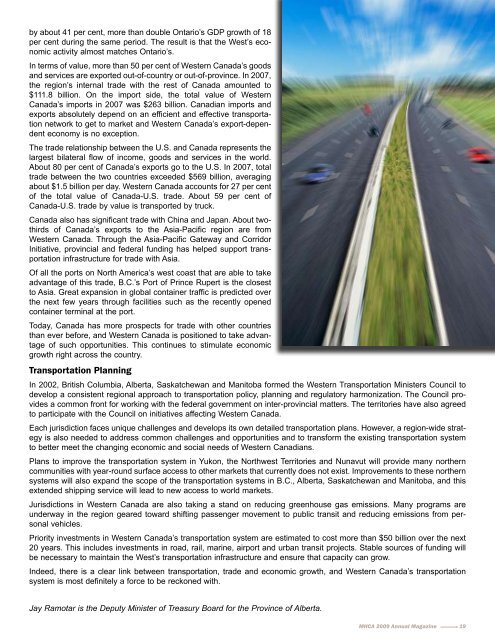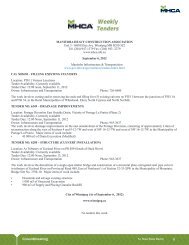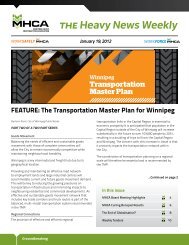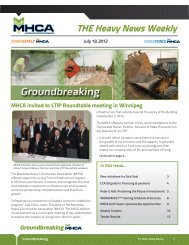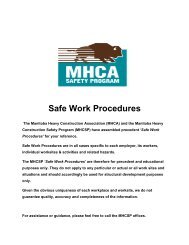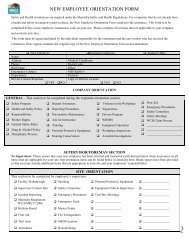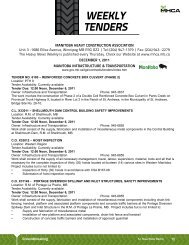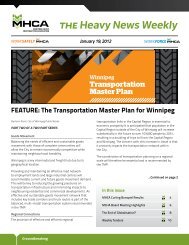2009 Annual Magazine - Manitoba Heavy Construction Association
2009 Annual Magazine - Manitoba Heavy Construction Association
2009 Annual Magazine - Manitoba Heavy Construction Association
You also want an ePaper? Increase the reach of your titles
YUMPU automatically turns print PDFs into web optimized ePapers that Google loves.
y about 41 per cent, more than double Ontario’s GDP growth of 18per cent during the same period. The result is that the West’s economicactivity almost matches Ontario’s.In terms of value, more than 50 per cent of Western Canada’s goodsand services are exported out-of-country or out-of-province. In 2007,the region’s internal trade with the rest of Canada amounted to$111.8 billion. On the import side, the total value of WesternCanada’s imports in 2007 was $263 billion. Canadian imports andexports absolutely depend on an efficient and effective transportationnetwork to get to market and Western Canada’s export-dependenteconomy is no exception.The trade relationship between the U.S. and Canada represents thelargest bilateral flow of income, goods and services in the world.About 80 per cent of Canada’s exports go to the U.S. In 2007, totaltrade between the two countries exceeded $569 billion, averagingabout $1.5 billion per day. Western Canada accounts for 27 per centof the total value of Canada-U.S. trade. About 59 per cent ofCanada-U.S. trade by value is transported by truck.Canada also has significant trade with China and Japan. About twothirdsof Canada’s exports to the Asia-Pacific region are fromWestern Canada. Through the Asia-Pacific Gateway and CorridorInitiative, provincial and federal funding has helped support transportationinfrastructure for trade with Asia.Of all the ports on North America’s west coast that are able to takeadvantage of this trade, B.C.’s Port of Prince Rupert is the closestto Asia. Great expansion in global container traffic is predicted overthe next few years through facilities such as the recently openedcontainer terminal at the port.Today, Canada has more prospects for trade with other countriesthan ever before, and Western Canada is positioned to take advantageof such opportunities. This continues to stimulate economicgrowth right across the country.Transportation PlanningIn 2002, British Columbia, Alberta, Saskatchewan and <strong>Manitoba</strong> formed the Western Transportation Ministers Council todevelop a consistent regional approach to transportation policy, planning and regulatory harmonization. The Council providesa common front for working with the federal government on inter-provincial matters. The territories have also agreedto participate with the Council on initiatives affecting Western Canada.Each jurisdiction faces unique challenges and develops its own detailed transportation plans. However, a region-wide strategyis also needed to address common challenges and opportunities and to transform the existing transportation systemto better meet the changing economic and social needs of Western Canadians.Plans to improve the transportation system in Yukon, the Northwest Territories and Nunavut will provide many northerncommunities with year-round surface access to other markets that currently does not exist. Improvements to these northernsystems will also expand the scope of the transportation systems in B.C., Alberta, Saskatchewan and <strong>Manitoba</strong>, and thisextended shipping service will lead to new access to world markets.Jurisdictions in Western Canada are also taking a stand on reducing greenhouse gas emissions. Many programs areunderway in the region geared toward shifting passenger movement to public transit and reducing emissions from personalvehicles.Priority investments in Western Canada’s transportation system are estimated to cost more than $50 billion over the next20 years. This includes investments in road, rail, marine, airport and urban transit projects. Stable sources of funding willbe necessary to maintain the West’s transportation infrastructure and ensure that capacity can grow.Indeed, there is a clear link between transportation, trade and economic growth, and Western Canada’s transportationsystem is most definitely a force to be reckoned with.Jay Ramotar is the Deputy Minister of Treasury Board for the Province of Alberta.MHCA <strong>2009</strong> <strong>Annual</strong> <strong>Magazine</strong> 19


